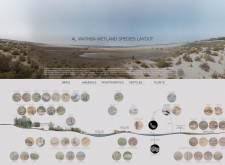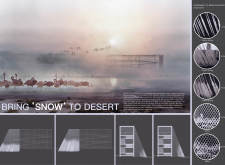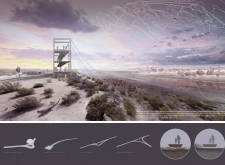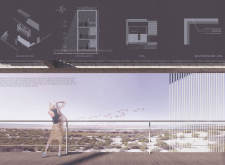5 key facts about this project
The design at Al Wathba Wetland aims to enhance the natural beauty and ecological function of its diverse habitats while offering meaningful experiences for visitors. Located within a unique landscape of wetlands, the project focuses on supporting local wildlife, particularly the Greater Flamingo, while seamlessly integrating with the surrounding environment. The approach centers on accessibility and the preservation of natural features.
Elevated Pathways
The design includes elevated pathways and viewing platforms that allow wildlife to move freely beneath them. These walkways are supported by slender metal pillars, ensuring that the structures have minimal physical and visual impact on the landscape. The elevation provides visitors with a unique vantage point to observe the wetlands, creating an interaction with the habitat without intruding upon it.
Seasonal Adaptation
Seasonal changes play a significant role in the design. A steel veil is incorporated to respond to rising water levels during the winter months. This feature allows for the collection of salt crystals on the tower's facade, which visually reflects the wetland’s transformations. The structure adapts to the rhythm of nature, making the built environment responsive to its surroundings.
Material Choices
Materials selected for the project serve both functional and aesthetic purposes. Steel is used to provide structural strength while maintaining a clean, modern appearance. This choice of material is practical and supports the overall theme of environmental awareness, as it connects the built elements back to the natural landscape.
Delicate Details
The focus on details is evident in the design's interaction with the site. Pathways transition smoothly into the landscape, while the salt accumulation on the steel facade adds a dynamic visual element that changes with the seasons. This interplay between nature and the built environment creates an experience that highlights the relationship between architecture and ecology, encouraging visitors to engage with the wetland in a thoughtful way.

























































